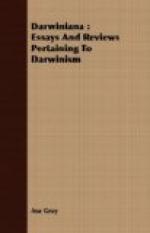Views so idealistic as those upon which his “Thoughts upon Species” [I-2] are grounded, will not harmonize readily with a doctrine so thoroughly naturalistic as that of Mr. Darwin. Though it is just possible that one who regards the kinds of elementary matter, such as oxygen and hydrogen, and the definite compounds of these elementary matters, and their compounds again, in the mineral kingdom, as constituting species, in the same sense, fundamentally, as that of animal and vegetable species, might admit an evolution of one species from another in the latter as well as the former case.
Between the doctrines of this volume and those of the other great naturalist whose name adorns the title-page of this journal, the widest divergence appears. It is interesting to contrast the two, and, indeed, is necessary to our purpose; for this contrast brings out most prominently, and sets in strongest light and shade, the main features of the theory of the origination of species by means of Natural Selection.
The ordinary and generally-received view assumes the independent, specific creation of each kind of plant and animal in a primitive stock, which reproduces its like from generation to generation, and so continues the species. Taking the idea of species from this perennial succession of essentially similar individuals, the chain is logically traceable back to a local origin in a single stock, a single pair, or a single individual, from which all the individuals composing the species have proceeded by natural generation. Although the similarity of progeny to parent is fundamental in the conception of species, yet the likeness is by no means absolute; all species vary more or less, and some vary remarkably—partly from the influence of altered circumstances, and partly (and more really) from unknown constitutional causes which altered conditions favor rather than originate. But these variations are supposed to be mere oscillations from a normal state, and in Nature to be limited if not transitory; so that the primordial differences between species and species at their beginning have not been effaced, nor largely obscured, by blending through variation. Consequently, whenever two reputed species are found to blend in Nature through a series of intermediate forms, community of origin is inferred, and all the forms, however diverse, are held to belong to one species. Moreover, since bisexuality is the rule in Nature (which is practically carried out, in the long-run, far more generally than has been suspected), and the heritable qualities of two distinct individuals are mingled in the offspring, it is supposed that the general sterility of hybrid progeny interposes an effectual barrier against the blending of the original species by crossing.
From this generally-accepted view the well-known theory of Agassiz and the recent one of Darwin diverge in exactly opposite directions.
That of Agassiz differs fundamentally from the ordinary view only in this, that it discards the idea of a common descent as the real bond of union among the individuals of a species, and also the idea of a local origin—supposing, instead, that each species originated simultaneously, generally speaking, over the whole geographical area it now occupies or has occupied, and in perhaps as many individuals as it numbered at any subsequent period.




